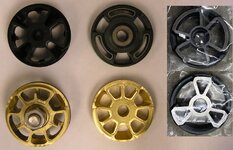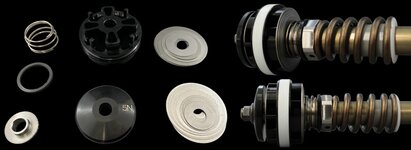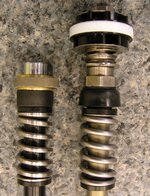I love air forks! My first real dirt bike ('74 CR125M, 175cc now) had a Goki air kit to both legs fm a single valve, & worked great for years - silky smooth, handled everything including massive hits, and was so much better than any of the other bikes I rode back then.
I was hoping my AER fork was a modern version of that, but it felt like a stiff dry-binding spring fork. I wasted a bunch of time online ("they have to break in! you need MORE PRESSURE!!"), removed air ('102 psi minimum' yeah right, I got down to 85 psi and it still wasn't compliant enough), revalved (helped the damping, not the springing), and searched for options. Afaik the only ones available are spring conversions and the Kreft Moto Plush Tank, which doesn't address what I feel is the main AER problem - lack of lubrication in the air spring (more on that in a later post).
I wasted a bunch of time online ("they have to break in! you need MORE PRESSURE!!"), removed air ('102 psi minimum' yeah right, I got down to 85 psi and it still wasn't compliant enough), revalved (helped the damping, not the springing), and searched for options. Afaik the only ones available are spring conversions and the Kreft Moto Plush Tank, which doesn't address what I feel is the main AER problem - lack of lubrication in the air spring (more on that in a later post).
At any rate... I'm done with my 2nd revalve and done-for-now converting to simple air pressure (WP air spring cartridge removed), w/everything fully oil-bath lubricated & no more grease BS. Normally I wouldn't post till it was 100% complete & fully tested - it still needs a custom top-out spring - but that may be months away and I want to spend this summer riding. I've got 6 rides on it so far & I'm happy with how it works as-is, but the custom spring will make it work even better & for a larger group of riders. Race Tech may be helping me with the spring, but if not it's back to Cannon.
Results (this is a work in progress): It's night-and-day different from stock; nearly stictionless, super compliant, & only soft-bottoming once when it had too little oil. There's occasional mild top-out and a lot of brake dive (I'm working on it) which I depend on when setting up for corners, and I think most riders would consider it too soft at first - so did I (working on that too). After the second ride I realized it only seemed too soft during hard braking. and with more and more oil, diving reduced. Now it feels great to me - that 70's show but with more travel and frame / fork rigidity. Once I have the correct top-out spring - which sort-of works as a small negative air chamber - I can use more psi to improve mid-stroke support & reduce dive without top-out. Like my Ohlins shock, this mod is intended for below-50mph trail riding. Btw - can anyone help me with the SKF fork seal part number, so I can get the specs? I couldn't find it online, and SKF may never get back to me.
DAMPING SIDE
After my 1st revalve I found the Alta AER's restrictive OEM damping piston still had too much compression damping and was really hard on shims, so I replaced it with a Krooztune hi-flow MV-float setup (I think the Krooztune may have the most flow possible in an aluminum piston). My goal here was the same as my Ohlins shock - max grip, min. pain. I need my suspension to be workers, not fighters.
KTM / AER service manual - hard to find for free online, PM if you need one
Rebuild video:
Some AER pistons - clockwise fm top left, the Krooztune, Alta OEM, 2018 KTM AER (x2, both in plastic), Race Tech base valve, & RT RD/MV main piston:

Rebound stack (6mm ID, face shim 1st, conventional no-float setup - next revalve I may remove a few shims):
28 x .10 [x2]
20 x .10
10 x .15
28 x .10
26 x .10
24 x .10
22 x .10
20 x .10
18 x .10
16 x .10
14 x .10
12 x .10
10 x .30
16 x .30 buffer
Mid-valve 'float stack' (8mm ID, basically a check valve - see float-setup pic below, works EX)
30 x .10 [x3] float shims
20 x .10 spring buffer

Compression / base valve: no piston or stack used. There's 380cc of Redline Likewater in the damping cartridge, and 200cc in the RH fork leg (400cc would be better for my air setup).
SPRING SIDE
Testing: I first wanted to find out if I was wasting my time converting to air-only. The easiest way is to remove air pressure & the entire Schrader valve assembly fm the LH fork cap (M10 socket), compress the fork a bit & squirt in 15cc of Tri-Flow or other low-friction lubricant to minimize piston scrape, then replace the cap bleeder screw with the valve (both cap holes are M8 x 1.0 thread, leave the OEM-Schrader hole open for testing). Put 45-50 psi of air in the valve and try it out; the 15cc lube should quickly find its way into the negative air chamber, so I wouldn't worry about the open hole squirting oil. Do not ride the bike this way for long, but it should give you an idea of how much less stiction it has, even with the air spring in (spring-out is way less). My short street-only test ride (spring out) was brake-dive-city since I only had 200cc oil, but my fork felt slick and stiction-free for the first time - during the ride I could compress & extend it easily w/just small amounts of throttle. At that point I decided to commit to making it work, and I'm glad I did.
After that, I put in a Race Tech FSCS WC38050915 'stealth' spring-conversion unit ($534 shipped with the 10% ThumperTalk discount) to limit extension and provide a 2nd top-out spring (the OEM one in the RH damping leg wasn't enough). I figured if the air thing didn't work I'd go with steel; no way the air spring's going back in. Below is a pic w/spring (not used):

The RT unit is high quality and light - @ 1 lb/480g, about the same as the air spring. 'Stealth' means re-using the stock cap, so remove it fm the cartridge (tools needed are 37mm tube clamp / vise / torch / cap wrench / etc.). The cap bleeder / Schrader valve ass'y / O-ring must be removed and the torch used on the cap's black outer threads - the inner super-fine threads w/red Loctite to be loosened are under them. I had to apply heat twice to finally get it off, but no damage. The Schrader valve and bleeder screw should be reinstalled in the cap in their OEM positions, then the RT unit can be set up & installed in the LH fork leg per the instructions (remove & save the spring seat / ring nut / washers / large-OD spring sleeve), along with 680cc of any type / weight fork oil. Once it's together & back on the bike (0 psi), put the front wheel on, add 36 psi of air, done.
I've got a bunch of AER-related blather that might be of interest, which I'll try to post at some point - this one's way too long already.
I was hoping my AER fork was a modern version of that, but it felt like a stiff dry-binding spring fork.
At any rate... I'm done with my 2nd revalve and done-for-now converting to simple air pressure (WP air spring cartridge removed), w/everything fully oil-bath lubricated & no more grease BS. Normally I wouldn't post till it was 100% complete & fully tested - it still needs a custom top-out spring - but that may be months away and I want to spend this summer riding. I've got 6 rides on it so far & I'm happy with how it works as-is, but the custom spring will make it work even better & for a larger group of riders. Race Tech may be helping me with the spring, but if not it's back to Cannon.
Results (this is a work in progress): It's night-and-day different from stock; nearly stictionless, super compliant, & only soft-bottoming once when it had too little oil. There's occasional mild top-out and a lot of brake dive (I'm working on it) which I depend on when setting up for corners, and I think most riders would consider it too soft at first - so did I (working on that too). After the second ride I realized it only seemed too soft during hard braking. and with more and more oil, diving reduced. Now it feels great to me - that 70's show but with more travel and frame / fork rigidity. Once I have the correct top-out spring - which sort-of works as a small negative air chamber - I can use more psi to improve mid-stroke support & reduce dive without top-out. Like my Ohlins shock, this mod is intended for below-50mph trail riding. Btw - can anyone help me with the SKF fork seal part number, so I can get the specs? I couldn't find it online, and SKF may never get back to me.
DAMPING SIDE
After my 1st revalve I found the Alta AER's restrictive OEM damping piston still had too much compression damping and was really hard on shims, so I replaced it with a Krooztune hi-flow MV-float setup (I think the Krooztune may have the most flow possible in an aluminum piston). My goal here was the same as my Ohlins shock - max grip, min. pain. I need my suspension to be workers, not fighters.
KTM / AER service manual - hard to find for free online, PM if you need one
Rebuild video:
Some AER pistons - clockwise fm top left, the Krooztune, Alta OEM, 2018 KTM AER (x2, both in plastic), Race Tech base valve, & RT RD/MV main piston:

Rebound stack (6mm ID, face shim 1st, conventional no-float setup - next revalve I may remove a few shims):
28 x .10 [x2]
20 x .10
10 x .15
28 x .10
26 x .10
24 x .10
22 x .10
20 x .10
18 x .10
16 x .10
14 x .10
12 x .10
10 x .30
16 x .30 buffer
Mid-valve 'float stack' (8mm ID, basically a check valve - see float-setup pic below, works EX)
30 x .10 [x3] float shims
20 x .10 spring buffer

Compression / base valve: no piston or stack used. There's 380cc of Redline Likewater in the damping cartridge, and 200cc in the RH fork leg (400cc would be better for my air setup).
SPRING SIDE
Testing: I first wanted to find out if I was wasting my time converting to air-only. The easiest way is to remove air pressure & the entire Schrader valve assembly fm the LH fork cap (M10 socket), compress the fork a bit & squirt in 15cc of Tri-Flow or other low-friction lubricant to minimize piston scrape, then replace the cap bleeder screw with the valve (both cap holes are M8 x 1.0 thread, leave the OEM-Schrader hole open for testing). Put 45-50 psi of air in the valve and try it out; the 15cc lube should quickly find its way into the negative air chamber, so I wouldn't worry about the open hole squirting oil. Do not ride the bike this way for long, but it should give you an idea of how much less stiction it has, even with the air spring in (spring-out is way less). My short street-only test ride (spring out) was brake-dive-city since I only had 200cc oil, but my fork felt slick and stiction-free for the first time - during the ride I could compress & extend it easily w/just small amounts of throttle. At that point I decided to commit to making it work, and I'm glad I did.
After that, I put in a Race Tech FSCS WC38050915 'stealth' spring-conversion unit ($534 shipped with the 10% ThumperTalk discount) to limit extension and provide a 2nd top-out spring (the OEM one in the RH damping leg wasn't enough). I figured if the air thing didn't work I'd go with steel; no way the air spring's going back in. Below is a pic w/spring (not used):

The RT unit is high quality and light - @ 1 lb/480g, about the same as the air spring. 'Stealth' means re-using the stock cap, so remove it fm the cartridge (tools needed are 37mm tube clamp / vise / torch / cap wrench / etc.). The cap bleeder / Schrader valve ass'y / O-ring must be removed and the torch used on the cap's black outer threads - the inner super-fine threads w/red Loctite to be loosened are under them. I had to apply heat twice to finally get it off, but no damage. The Schrader valve and bleeder screw should be reinstalled in the cap in their OEM positions, then the RT unit can be set up & installed in the LH fork leg per the instructions (remove & save the spring seat / ring nut / washers / large-OD spring sleeve), along with 680cc of any type / weight fork oil. Once it's together & back on the bike (0 psi), put the front wheel on, add 36 psi of air, done.
I've got a bunch of AER-related blather that might be of interest, which I'll try to post at some point - this one's way too long already.
Last edited:


